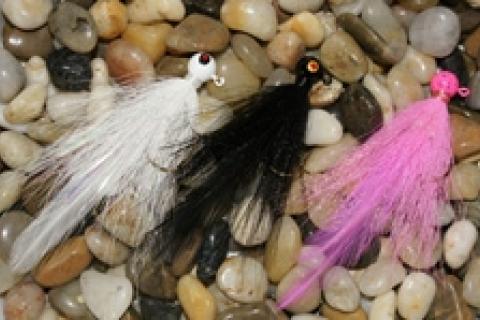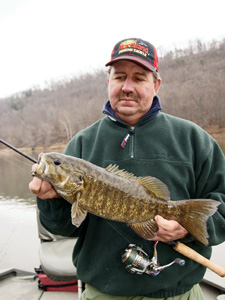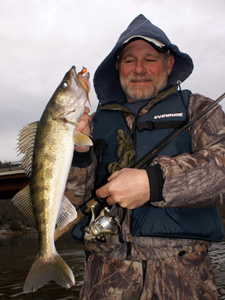
Given the huge range of soft bodies available to adorn leadhead jigs, it's of little surprise that bucktail jigs, once standard fare, see little use by the majority of today's anglers. The cost of overlooking hair jigs — dismissing the splendor of au naturel — is one paid in fewer bites from gamefish such as bass and walleyes.
 |
| Craig Mason with one of many quality-sized smallmouth bass taken on bucktails during a fall river trip. |
Given the huge range of soft bodies available to adorn leadhead jigs, it's of little surprise that bucktail jigs, once standard fare, see little use by the majority of today's anglers. The cost of overlooking hair jigs — dismissing the splendor of au naturel — is one paid in fewer bites from gamefish such as bass and walleyes. When water temperatures range from cool to cold, the simplicity and effectiveness of bucktail jigs excels.
Though commonly called bucktail jigs, hair jigs are fashioned from a diversity of natural fur. Besides deer, other materials include bear and elk hair. Though technically a feather, marabou is another common source. I find rabbit fur jigs — made from diminutive skin strips (a combination of crosscut and zinger) with the fur still attached — effective many fall days. Regardless, it's the breathing look provided by water pulsating through the natural body and hair that gives bucktails a unique and real-life look.
I recall an early November day during a recent fall when Craig Mason and I spent a productive day fishing a free-flowing river for smallmouth bass. The water temperature was in the high 40s, with the level up just enough to create a fairly strong flow in the main river areas. These are perfect conditions for river smallmouth bass during the fall. With strong current in much of the river, the fish were pushed back in protected areas near the bank. Shoreline irregularities in the form of rock formations and gravel points deflected the current, providing quiet pockets that held biting bass. While the water was cold, it was certainly not too cold for river smallies. They eagerly took our hair jigs as we pitched them back into the sweet spots as the boat slowly drifted along.
The key to working a bucktail in this situation is to make a short cast right next to the bank. Even in the fall, smallmouth bass will often get in extremely shallow water, particularly when they are feeding. Fish in this position will inhale the jig on its initial fall. If one doesn't, work the bucktail back toward the boat, using a lift-drop retrieve, one that doesn't give the jig too much freedom so it doesn't drop down in the rocks and snag. Once the jig is back under the boat I like to let in hang vertically for a few seconds, as fish will also often orient themselves in this spot, the current seam separating the river's main flow from the slackwater pocket.
Big rivers are a classic location for using bucktails in the fall. The quarry is often walleye, though depending on the species available in a given river, sauger, bass, northern pike, even muskies are often taken in this situation. As with the previous example, gamefish will have positioned themselves in protected areas, places where in many instances they'll spend the winter. But here we're considering larger slackwater areas, as opposed to quiet shoreline pockets. Rather, these are larger pools, often found downriver from sizeable structures like wingdams, rock points and islands — sizeable physical features that ward off the current.
Since these areas are substantial, covering the water in search of fish active enough to bite, despite the cold water, is the objective. Bucktails shine in this situation, one in which boat control is a crucial aspect as well. Over deeper areas — roughly 10 feet or more — it's more efficient to drift along, fishing the bucktail directly under the boat. Use the trolling motor to make speed corrections so that the boat inches along.
 |
| Sid Brown took this walleye on a bucktail from a large river during a January trip. |
Allow the bucktail to hover a few inches over the bottom, which is the zone most fish will be in at this time. Occasionally drop the jig down so it kisses the bottom, to be sure you're in the right area. Also, incorporate some vertical jigs to the bucktail, snapping it upward a few inches, then falling on a semi-tight line.
When you're over shallower water you can make pitch casts over the flat, working the bucktail back to the boat with a subtle lift-drop retrieve, or even a straight drag.
While the same basic methods can be made using a classic jig-n-minnow combo, the bucktail jig gives you some advantages. For one, you can snap jig it vertically, an action that often rips a live minnow off a jig. Similarly, when repetitively cast, a live fathead minnow quickly becomes unattached. And if you wish to include a minnow as part of your presentation, it's a simple matter of tipping the bucktail with an artificial minnow like Berkley's Gulp Alive Minnow. These guys will stay on the hook; I've found them to work as well or better than live minnows.
Cold-water bucktail use isn't limited to rivers. On both lakes and reservoirs gamefish will often hover off of main lake points, typically at the same level at which schools of baitfish are holding. In most cases you'll see the presence of both on your sonar unit. A bucktail cast over these areas filters down through the fish, a free-falling look that often triggers a bite. You can also vertically jig a bucktail in or above the schools.
When the wind's correct a bucktail jig is a terrific option for drifting along a breakline. Many years back a partner of mine, Sid Brown, wiped my eyes for me in such a scenario. It was on a major bay of a Great Lake, one that holds big smallmouth bass at certain times of the year. I'd just pulled up on the edge of a flat, the break where an expanse of 6-8 feet of water quickly gave way to 25- to 30-foot depths. While I was rigging up a tube jig — an offering that typically worked well on this water — Sid pitched a white bucktail overboard, and began snap jigging it as the boat was pushed along by the gentle west wind. Soon he was into a 4-pound smallie. And then another, and another, all before I'd gotten my tube tied on. I didn't have bucktails with me that day. It's a mistake I haven't made since.
Bucktail TipsThe thickness and length of hair varies among jigs — often a reflection of the preferences of the person that tied it. In general, ones with sparser hair tend to be more effective, as the hair has more room to breathe. Use jigs with shorter hairs when tipping with a minnow. Longer hairs provide a longer profile and work best when fished without tipping.
|
- 11264 views

